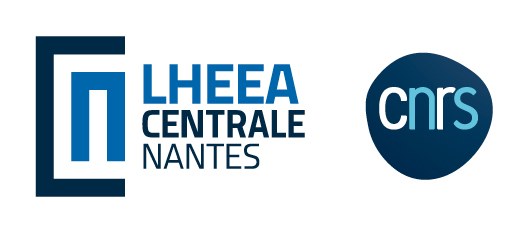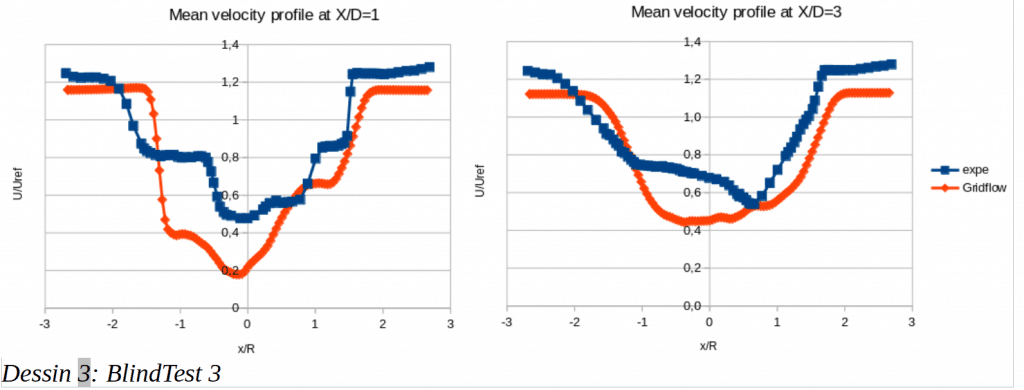
Background
Forecast studies for the siting of offshore wind farms use engineering models to consider the interactions of wind turbines with each other. The representation obtained of these phenomena remains incomplete, while important issues are linked to this configuration. In particular, the wind observed at the turbines located in the wake of other wind turbines is strongly disturbed.
The ATMOSFARM project is presented as a logical continuation of the WEAMEC project ECOSFARM. During the ECOSFARM project, a coupling has been carried out between the Navier-Stokes solver Grid-flow (former WCCH) and the wind turbine simulation tool FAST developped by the NREL. The tool obtained makes it possible to obtain a fine representation of the flows within a wind farm. A proof of concept was performed on a small scale case, where very promising results were obtained. However, before being able to simulate wind farms in real conditions, it is necessary to take into account a realistic distribution of the wind and its evolution within the park.
During the ATMOSFARM project, Grid-flow will be optimized and interfaced with the LES code of the NCAR. This coupling will make it possible to simulate various realistic atmospheric environments. When used with FAST, full scale wind farm simulations can be performed. The developments carried out within the framework of this project will make the Grid-flow / FAST coupling more efficient, and provide an additional step forward for the CFD simulation wind farms
Scientific advances and innovation
Only 5 other codes have been identified as provinding a similar levels of precision and optimization as the one targeted by the Grid-flow/FAST coupling. Compared those tools, Grid-flow/FAST is designed to provide an important flexibility both in the simulation setup process and to follow the motion of simulated structures. This second feature gives a potential for the simulation of floating wind turbines, which could be the subject of a future project.
Expected technical and economic impact
The implementations planned within the ATMOSFARM project should allow the simulation of interactions between wind turbines at full scale. Grid-flow is distributed by NextFlow Software. The implementations realized during the ATMOSFARM project will be integrated to the software tools of NextFlow Software.
Key project milestones
- June 2021 - ATMOSFARM project starts
- Novembre 2021 - Numerical schemes optimized and validation on small scaled completed
- Novembre 2021 - Atmospheric boundary layer at full scale simulated and demonstrator set
Demonstrator
The ATMOSFARM project uses the coupling Grid-flow/FAST which was developped during the ECOSFARM project. This previous WEAMEC-funded project shows a proof of concept for the simulation of wake interactions between wind turbines.
Results
December 2021
During the last 6 months, the developments have focused on the handling and optimization of the Gridflow/FAST coupling.
An in-progress calculation recovery facility has been set up, which is necessary for large-scale simulations
The simulations have been optimized at different points.
The post-processing devices have been parallelized.
Following these developments, a validation was carried out on small-scale academic cases. The BlindTest version 1 (Krogstad et al, 2013), 2 (Pierella et al, 2014) and 3 (Krogstad et al, 2015) cases, which provide experimental wind tunnel data, were used.
- The results obtained with BlindTest 1 showed an interesting accuracy when moving away from the wind turbine. The results obtained in the near wake remain perturbed, due to the use of an Actuator Line method.
- The results obtained with BlindTest 2 show a satisfactory accuracy. We also observe an improvement in the quality of the results compared to those obtained during the ATMOSFARM project. These differences can be explained by the improvement of the Gridflow resolution scheme,s as well as by the correction of bugs in the Gridflow/FAST coupling.
- Preliminary results obtained in BlindTest 3 show significant deviations from the experimental results. Work is in progress to improve the consideration of interactions between wind turbines.
Comparisons have also been made to measure the influence of gradient reconstruction schemes.
The last point concerns the transition to a purely implicit temporal scheme. Preliminary work to adapt this scheme to the context of the Gridflow/FAST coupling is in progress.
Prospects
The ability to simulate accurately an atmospheric boundary layer is the last obstacle before simulating wind turbine interactions at full scale. Further developments could allow the simulations of floating wind turbine.










